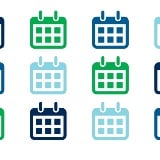When planning to build a home, one of the most frequently asked questions is how much cash will I need?
This article is part 1 of our “Building a Home” series.
The answer is different with every home and every home buyer, but we can give you a better understanding of the financing needed to build a home. And of course, a Rural 1st loan officer can provide specific answers for your own home construction plans.
Let’s take a look at the different categories of cash requirements in new home construction. They include the down payment, cash reserves, and closing costs.
Most home purchases include some type of down payment associated with financing. The down payment is your commitment and shared financial risk related to the project. The more you put down, the more owner equity you have in the property. And it’s not always cash. Some or all of your down payment may come from equity you have in a lot purchased earlier.
The amount you can finance varies on the home type you are planning to build. Stick-built, modular, log and barndominium style homes allow for the highest level of financing we offer. For barndominium and log homes we also use conventional loans so you don’t have to pay more for the home of your dreams. Many lenders view these home types as non-conventional.
Another home type includes nonconventional home styles, such as machine shed, berm, and manufactured homes, which can carry more risk and may require a larger down payment than a traditional home.
Let’s move on to discuss the cash reserves requirement. Your cash reserves should be thought of as a safety net in case your project goes over budget. And while you may not have to spend this cash, and hopefully you won’t, it is a requirement to demonstrate you have funds to cover overages should they occur. The cash reserves amount varies based on the contractor arrangement you choose. Self contractor arrangements require more cash reserves and your loan officer can provide additional information.
Using a general contractor, for example, is the most common and least risky strategy. Cash reserve requirements for this type of project would likely be 5% of the construction costs. In determining cash reserves, we’ll use the total cost of construction, not the appraised value, as the basis for the calculation. That gives you the best estimate for your safety net. The money needed for cash reserves can be funded from sources such as savings, retirement, and liquid investments.
And finally, closing costs are another expense to consider. They can include title insurance, appraisals, taxes, and more. These expenses will vary depending on the location of the home, the amount financed, and loan terms. Closing costs can often be rolled into your loan, so you may not need added cash for them. However, in doing so, they will become part of your loan balance and accrue interest.
There are a lot of moving parts to a construction loan. Having some idea of the potential cash required to finance your build will help you know if you’re ready to get started. Rural 1st offers a network of experienced lending officers who can help you determine the cash you need to build your home.
Learn more about how much of your construction you can finance. When you’re ready to get Closer to What Matters®, connect with a loan officer.

-v2_01_03_05_15.tmb-square-tny.jpg?Culture=en&sfvrsn=3ab18753_1)


